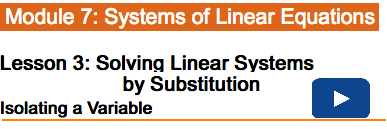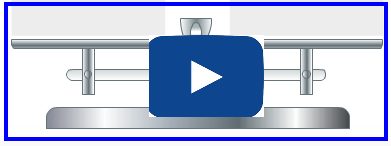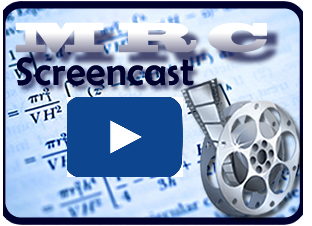Lesson 3: Solving Linear Systems by Substitution
| Site: | MoodleHUB.ca 🍁 |
| Course: | Mathematics 10C |
| Book: | Lesson 3: Solving Linear Systems by Substitution |
| Printed by: | Guest user |
| Date: | Friday, 19 December 2025, 5:23 AM |
Module 7: Systems of Linear Equations
Lesson 3: Solving Linear Systems by Substitution
Focus

iStockphoto/Thinkstock
The Edible Schoolyard is a school garden program that was founded in Berkeley, California, in 1995 by Alice Waters, who is both a chef and an author. The program has now spread throughout the United States and Canada.
Originally implemented to combat childhood obesity, the Edible Schoolyard is designed to help students learn about the importance of fresh foods and healthy eating. Children in the program learn how to tend a garden from planting the seeds through to the harvesting of the crop. Students also learn how to prepare meals and dishes using the food they have grown. The Edible Schoolyard has met with both success and criticism. School authorities have seen an improvement in student well-being, while critics suggest that the program is a distraction from learning the basics.
Gardening and cooking are recreational pursuits that are gaining in popularity, especially as people become more conscious about their health. There are many benefits to tending your own garden and cooking the food that it yields. Such benefits include the fact that you would be harvesting free food—food that is free of pesticides and preservatives.
In addition, studies show that working in a garden can help a person reduce stress. Gardening also provides many opportunities for physical exercise, including hoeing, planting, watering, and harvesting.
In this lesson you will learn to use algebraic techniques to solve systems of equations. You will see how linear systems can be used to solve problems related to gardening and cooking.
Outcomes
At the end of this lesson, you will be able to
- determine the solution of a system of linear equations by using the substitution method
- verify the solution of a system of linear equations algebraically
Lesson Questions
- How do you decide which variable to isolate? Does it matter?
- Why would you change a mathematical equation into an equivalent expression?
 Assessment
Assessment
As you work through each lesson, complete all the questions and learning activities in your binder using paper and pencil, clearly labeling your work (they refer to this as your course folder). These include the Are you Ready, Try This, Share and Self Check questions. Check your work if answers are provided. Remember that these questions provide you with the practice and feedback that you need to successfully complete this course.
Once you have completed all of the learning activities, take the Lesson Quiz. This is the assessment for each lesson and is located under the Activities block on the left in moodle or under the Assess tab.
** Note – Share questions may have to be done on your own depending on your learning situation**
Module 7: Systems of Linear Equations
Launch
This section checks to see if you have the prerequisite knowledge and skills to be able to complete this lesson successfully.
Are You Ready?
Complete these questions in your binder. If you are experiencing difficulty, you may want to use the information and the multimedia in the Refresher section to clarify concepts before completing these exercises.
Once you have completed these exercises to the best of your ability, use the provided answer link to check your work.
Answers
If you feel comfortable with the concepts covered in the questions, move forward to Discover. If you experienced difficulties or want more practice, use the resources in Refresher to review these important concepts before continuing through the lesson or contact your teacher.
 Refresher
Refresher
The purpose of this section is to provide you with some resources to review in preparation for the lesson ahead. These resources may include videos, interactive applets, mini-lessons, and flash games to help you recall previously learned concepts. You can use these resources either before or after you try the questions in Are You Ready? Your teacher may also direct you to this section to review specific concepts.
--------------------------------
Visit Isolating a Variable to help you rearrange an equation.
---------------------------------
To see how to simplify an equation having fractions, look at Removing Fractions from an Equation.
--------------------------------
 Read
Read
To see how the distributive property can be used in multiplication, read an example from your textbook.
Foundations and Pre-calculus Mathematics 10 (Pearson)
Read “Example 1: Multiplying Two Binomials” on page 161.
Module 7: Systems of Linear Equations
Discover
You may work by yourself or with a partner to complete the activities in this section.
 Try This 1 - 6
Try This 1 - 6
Complete the following in your course folder ( binder).
Try This 1 - 6 Questions
Use the link below to check your answers to Try This 7 - 9.
Possible TT1-6 Solutions
 Watch and Listen
Watch and Listen
Use the “Pan Balance” game to continue to explore how you can determine unknown weights of different shapes.
Each shape has a predetermined weight. Your task is to explore how the weights of certain shapes compare with others.
- Select a shape and place it on one pan.
- Continue to select shapes and place them on either pan. When the pan balances, the program will save the configuration.
- Reset the pan and re-select different shapes that will result in a balanced scale.
- When you have enough clues about how the shapes balance, you can guess the weight of each shape.
There are six sets of problems. Try several sets to challenge yourself!
As you work through each set, see if you can determine the minimum number of configurations you need in order to determine the weight of each shape.
Module 7: Systems of Linear Equations
Explore

iStockphoto/Thinkstock
Cooking can be a rewarding pastime. (It’s the cleaning up afterwards that’s not as fun!) Cooking is a creative endeavour at the same time as it’s a scientific one. Reproducing recipes takes an eye for exactness and a lot of patience.
Cooking can also require a bit of improvisation. Sometimes a recipe calls for a certain type of spice that you don’t have on hand. Instead of running to the store to buy the ingredient, you can substitute a different spice for the one listed in the recipe. You may even discover that the food tastes better than the original!
Did you know that you can use applesauce instead of vegetable oil when you are baking brownies? In fact, substituting applesauce for oil is a common practice to reduce fat in one’s diet! It’s a healthier alternative that does not compromise the taste. There are also other ingredients that you can use instead of oil, including prune puree, canned pumpkin, and even baby food.
In this lesson you will learn how to solve systems of equations by employing the principle of substitution. You will also learn when it is most appropriate to use this method.
Beginning with this lesson you will learn how to solve a system of equations algebraically. This means that you will use techniques to manipulate the equations in the system to find the solution that satisfies both equations. The method you will learn about first is called substitution.
Glossary Terms
Add this term and its definition to the Glossary Terms section in your noted. You may also want to add examples that demonstrate how each term is applied.
- substitution method
-----------------------------------
 Try This 7 - 9
Try This 7 - 9
Complete the following in your course folder ( binder).
Try This 7 - 9 Questions
Use the link below to check your answers to Try This 7 - 9.
Possible TT 7 - 9 Solutions
In the Try This exercise above you may have used the principle of substitution to generate a concluding statement or equation. When you solve a system of equations by substitution, you are reducing the system to a single equation with only one unknown variable. It is an algebraic way to find the point of intersection we found in Lesson 1.
Solve by Substitution
Consider the following question:
Example: Consider the following system of equations.
x - 2y = 8
3x + y = 10
Solve the system. (Solving a system means to find the point of intersection).
Solution:
The steps outlined in Steps 1 - 5 show one way you can solve this system using the method of substitution.
Before we start, number the equations, so they are easier to talk about:
x - 2y = 8 (1)
3x + y = 10 (2)
Step 1. Choose an equation. Isolate one of the variables in the equation.
A possibility is to solve (1) for x by adding 2y to each side.
x - 2y + 2y = 8 + 2y
x = 8 + 2y (1)
Step 2. Substitute the expression in step 1 into the other equation.
So substitute x = 8 + 2y into (2).
Equation (2) is 3x + y = 10. Replace the x with 8 + 2y
3x + y = 10
3(8+2y) + y = 10
Step 3. Expand the resulting expression, and solve for the unknown variable.
Use the distributive property.
24 + 6y + y = 10
24 + 7y = 10
24 - 24 + 7y = 10 - 24
7y = -14
7y/7 = -14/7
y = -2
Step 4. Substitute the answer from step 3. into one of the original equations to obtain the value of the other unknown.
Substitute y = -2 into the original equation (1) and solve for x.
x - 2y = 8 (1)
x - 2(-2) = 8
x + 4 =8
x + 4 - 4 = 8 - 4
x = 4
Step 5. Verify your solution by substituting the obtained values into the OTHER equation. IMPORTANT: Whatever equation we use in step 4, we use the other equation in the verification.
Since we used equation (1) in step 4, we use equation (2) in the verification.
3x + y = 10 (2)
sub x = 4 and y = -2 and make sure both sides equal.
3(4) + (-2) = 10
12 + ( -2) = 10
10 = 10
YES!!
So the solution or point of intersection is ( 4, -2).
 Share 1 - 3
Share 1 - 3
There are many ways of using the principle of substitution to solve a system of equations.
Work with a partner ( if possible) to complete the example above in a different manner using the substitution method.
Then answer the following questions:
1.When is it possible ( or a good idea) to use substitution to solve a system?
2. Which of the two ways of solving a system do you find most effective? Was there a difference? Explain why.
3.How does the substitution method compare with solving by graphing?
Possible S1-3 Solutions
-----------------------------------
When you have completed the Share activity, record any significant details relating to the method of substitution in your Strategies for Solving Linear Systems table you started in Lesson 2.
-----------------------------------
 Watch and Listen
Watch and Listen
Watch the following video for an example of Solving a Linear System using Substitution. There are also more practice questions on the bottom left you could do if you like.
Module 7: Systems of Linear Systems
Explore 2
![]() Read
Read
Go to the textbook in order to see how a system of equations is solved by using the method of substitution.As you read through the solution, see if you can figure out how to choose which equation to rearrange and which variable to isolate. Also, once you obtain one of the values (x or y), how do you choose an equation to solve for the other variable?
Foundations and Pre-calculus Mathematics 10 (Pearson)Read “Example 1: Solving a Linear System by Substitution” on pages 418 and 419. In what situations would Method 2, shown in the example, come in handy? |
While the systems may look different each time, you will always be able to solve them using the substitution method if a variable can be isolated in one equation and substituted into the other equation. In the next example, you will encounter a linear system that looks different from what you have seen so far in this module.
Can we come up with a way to use the substitution method to determine the solution?
Work through the next example to see one way that you can solve the system by first establishing an equivalent system with “more friendly” coefficients. You will explore equivalent systems more in the next lesson.
Example 2 Solve the linear system and then verify your solution.

Solution 2
Step 1: Clear the denominators by multiplying each equation by the constant corresponding to the lowest common multiple of the denominators. In this case, multiply the first equation by 4 and the second equation by 5.


The equivalent system is
6x - y = 40
5x + 3y = 110
Tada..... now we can solve this question like the others we have done...
Step 2: Isolate y in the equation (1), and substitute the resulting expression into equation (2).
![]()
Sub 6x - 40 into y in equation (2)

Step 3: Substitute x = 10 into the expression for y to find y.

Step 4: Verify the solution by substituting x = 10 and y = 20 into the original equations of the linear system.

Since both equations are true, ( 10, 20) or x = 10 and y = 20 is the solution.
![]() Watch and Listen
Watch and Listen

 Try This 10
Try This 10
Complete the following in your course folder ( binder).
Foundations and Pre-calculus Mathematics 10 (Pearson)
TT 10. Complete “Exercises” questions 4.a), 4.c), 5.a), 5.c), 7, 8.a), 11, 19.a), and 19.c) on pages 425 and 426.
Use the link below to check your answers to Try This 10.
Possible TT10 Solutions
Mathematics 10C Learn EveryWare © 2010 Alberta Education
Module 7: Systems of Linear Equations
Connect
 Lesson Assessment
Lesson Assessment
Complete the lesson quiz posted under the Quizzes link to the left in moodle or under the Assess tab and ensure your work in your binder (course folder) is complete.
 Project Connection ** NOT ASSIGNED**
Project Connection ** NOT ASSIGNED**

Hemera/Thinkstock
There’s plenty of fun to be had at an amusement park.
In fact, many families look forward to the time when they can go vacationing together at theme parks such as Six Flags in the United States; PortAventura in Tarragona, Spain; Pleasure Beach Theme Park in the United Kingdom; or hundreds of others around the world. There is a lot to do at an amusement park, including playing games of skill and chance, going on thrilling rides, and eating carnival food.
In this Project Connection you will use linear systems to model three problems set in the context of amusement park activities. Go to the Unit 4 Project and complete the Module 7: Lesson 3 component.
 Going Beyond
Going Beyond
Deciding what to eat is a choice that seems simple, but it can have a powerful influence over your health. There is quite a bit of information available online about the foods in restaurants. You can search on the Internet using the keywords “fast food calories” to find websites that show you information about the content of menu items from a variety of restaurants.
Some people think that fast food should be avoided all together, and some people think that is it not a big deal if it is eaten in moderation. What do you think? Find a website using the keywords described in the preceding paragraph, and create a system of equations that you would use to convince someone that there is either a high risk or a low risk of eating French fries. (You may choose another menu item rather than French fries.)
For this task, you will need at least two unknowns and two equations to graph, so you can decide if you want to look at calories and sodium or any other combination of data you will find online. (Of course, by now, you know that all systems of equations must have at least two unknowns and two equations.)
Module 7: Systems of Linear Equations
Lesson 3 Summary
In this lesson you investigated the following questions:
- How do you decide which variable to isolate? Does it matter?
- Why would you change a mathematical equation into an equivalent expression?
In this lesson you learned how to solve linear systems using the substitution method. Like a recipe, where certain substituted ingredients can work just as well as another, the method of substitution can yield a correct solution just as well as the graphing method. In fact, substitution maintains an advantage over graphing. Sometimes, graphing may not yield an exact solution whereas substitution can.
You learned that when you employ substitution, you need to choose a variable to isolate. While it does not matter what variable you isolate, you may have discovered that it makes the most sense to choose the equation with the variable that is most easily isolated. This is most often the case when there is a variable with a coefficient equal to 1 or –1. In instances where no such term exists, you can still isolate any variable; however, the resulting expression may involve rational terms.
When you do encounter linear systems with rational coefficients, as you did in this lesson, you can multiply each term by a constant in order to obtain an equivalent linear system with integral coefficients. Depending on the constant that you choose, doing so could help you more easily isolate a variable.
In this lesson you engaged in several inquiry activities, including group work and applet-based exercises. You determined solutions and verified them according to previously learned techniques.
In the next lesson you will learn a second algebraic method that can be used to solve linear systems that is not amenable to substitution or graphing. You will see that there are certain ways of manipulating linear systems that do not change the solution to a problem. This new method, along with substitution, will serve as a solid foundation for you to solve any linear system.


